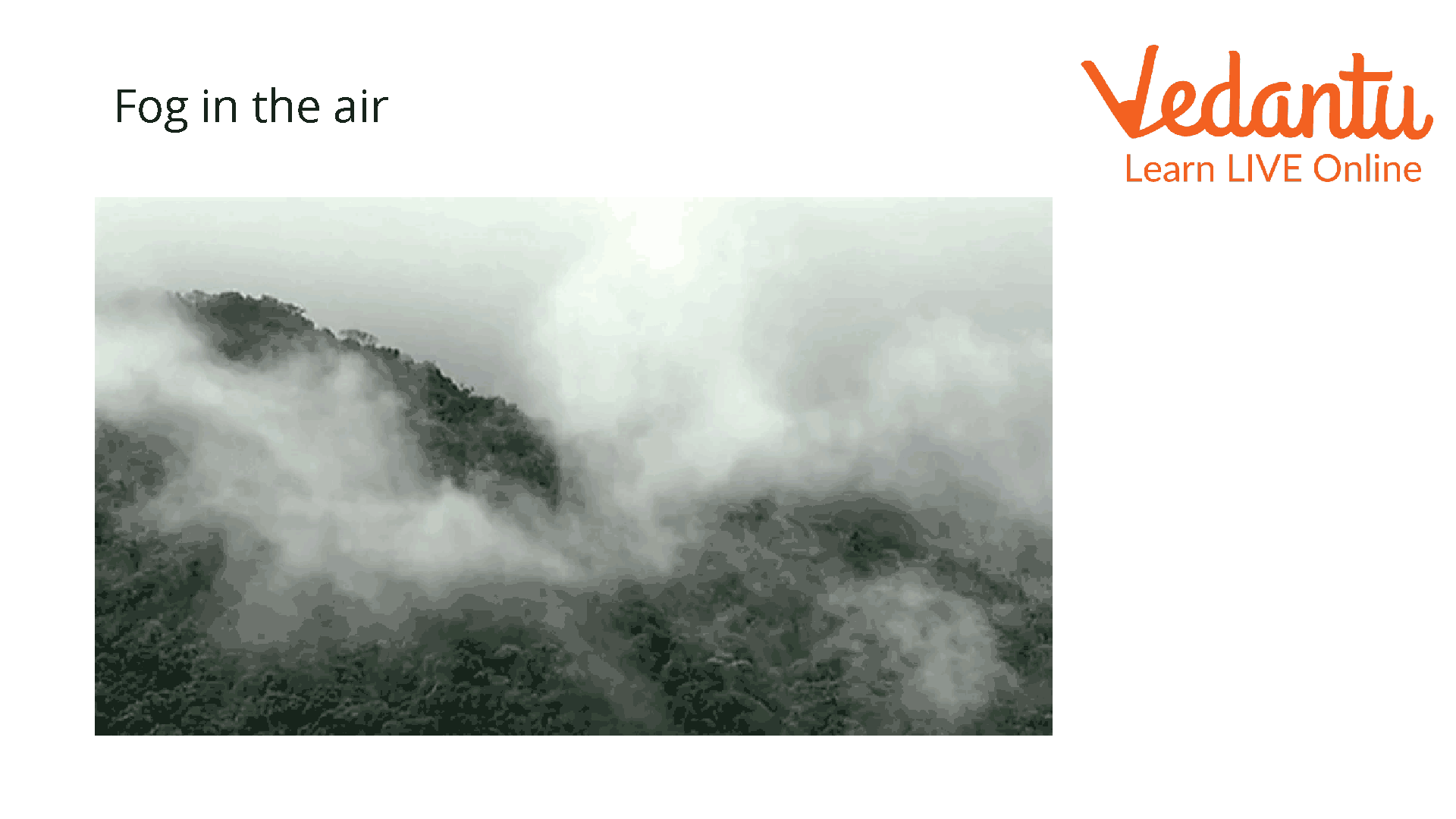




Introduction To Fog For Kids
A shallow air mass can become saturated from above and eventually reach the surface if warm, wet air overruns it. Since the moisture in the warm air is more than the moisture-carrying capacity of the cooler air, the contact cooling between the two air masses produces clouds and fog. When the temperature difference between the air and the dew point is less than 2.5 °C (4.5 °F), fog will arise—fog forms when water vapour condenses into tiny water droplets floating in the air.
It becomes foggy when it is humid. Fog cannot form without a significant amount of atmospheric water vapour.
Dust or another type of air pollution must be present for the fog to form.
As the air close to the ground cools and settles down, it forms overnight. Fog will develop as the air becomes saturated due to this cooling.
As the air continues to cool, fog will build at or near the surface and get thicker.

Fog in the Air
What Makes Fog?
Fog sometimes leads to zero visibility! Want to know how fog is made? Read below!
When water vapour, or water in its gaseous state, condenses, fog is made. The condensation process turns water vapour molecules into tiny liquid droplets that float in the air.
The air near the surface cools overnight as thermal radiation cools the land. This lowers the air's capacity to store moisture. After sunrise, radiation fog typically clears off.
Mornings are the coolest part of the day because the temperature dips to the dew point, and the relative humidity rises to nearly 100%. Dew points can sometimes reach air temperature, although most morning fog is made when the atmosphere cools.
Where Does The Fog Come From?
In essence, fog develops when warm air collides with colder air. Condensation is the name given to this process.
When the clusters of tiny droplets are close to the ground, we may see them as fog or clouds. Fog progressively fades as the air warms up again, and the fog progressively fades as the minute water droplets transform back into water vapour, a gas.
The fog comes in four basic types. When the sun sets, radiation fog develops as the ground radiates heat while the air above it starts to cool. Fog formation occurs when water vapour condenses around air pollutants when the atmosphere temperature drops below the dew point.
What Causes Mist?
When warmer air over water abruptly reaches the cooler surface of the land, mists frequently occur. Tiny water droplets suspended in the air are known as mist. The quick cooling of warmer atmospheric water transforms it from an invisible gas into tiny, visible water droplets.
Wherever there is a temperature rise, volcanic activity, or changes in humidity, water droplets are suspended in the air, and mist occurs.
The mist might make it difficult to see more than one or two kilometres (0.6 - 1.2 miles).
Water droplets can also condense into mist, but this process occurs less frequently. This indicates that when wind, temperature, or relative humidity change, the mist is less dense and evaporates more quickly.
Mists can be caused by sudden temperature changes (as when breathing in cold air), high humidity levels, or evaporation or condensation.
For example, rain hits rocks and other surfaces that have been warmed by the sun or when it starts to become cold at night and mist forms.

Mist
Conclusion
Water droplets produce fog and mist; their main differences are in their general locations and densities. Even if the "ground" is a hill or peak, fog is still a cloud that has reached that height. Any type of cloud that touches the ground can produce fog. A fog bank is a cloud formation that forms in low-lying places like valleys and plains and is subjected to the same wind and temperature reactions as clouds in the upper atmosphere.
FAQs on What Causes Fog in The Morning?
1. What is fog and what causes it to form in the morning?
Fog is a thick cloud of tiny water droplets suspended in the atmosphere at or near the Earth's surface. It forms in the morning when the air near the ground cools down. As the air cools overnight, it can no longer hold all of its water vapour. This excess vapour then condenses into microscopic liquid water droplets around tiny particles like dust or pollutants, creating the thick cloud we call fog.
2. Is fog a liquid or a gas?
Fog is a liquid. Although it is suspended in the air (which is a gas), fog itself is composed of millions of tiny liquid water droplets. It is different from water vapour, which is the gaseous, invisible state of water.
3. Is fog just a cloud that is touching the ground?
Yes, that's a perfect way to think about it. Fog is essentially a ground-level cloud. Both clouds and fog are formed through the same process of condensation, where water vapour turns into liquid water droplets. The only difference is their altitude; clouds form high up in the atmosphere, while fog forms at or very near the ground.
4. Why is fog more common during winter mornings?
Fog is more common in winter because the nights are longer and colder. This allows for a greater cooling of the ground and the air just above it. Cold air cannot hold as much moisture as warm air, so the air temperature is more likely to drop to the dew point—the temperature at which condensation occurs. This leads to the frequent formation of dense morning fog in winter.
5. What is the difference between fog and mist?
The primary difference between fog and mist is visibility, which means how far you can see. According to meteorologists:
- It is called fog if visibility is less than 1 kilometre (1,000 metres).
- It is called mist if visibility is more than 1 kilometre.
6. Are there different types of fog?
Yes, there are several types of fog based on how they form. The most common type seen in the morning is radiation fog. This forms on clear, calm nights when the ground radiates heat away, cooling the air above it to its dew point. Another type is advection fog, which forms when warm, moist air moves over a cooler surface, like a cold ocean current or snow-covered ground.
7. What does heavy morning fog indicate about the day's weather?
Morning fog, especially the common radiation fog, forms under clear skies and calm conditions. This often indicates that once the sun rises and its heat warms the ground, the fog will 'burn off' or evaporate. Therefore, a foggy morning is often a sign that the rest of the day will be sunny and clear with very little wind.









